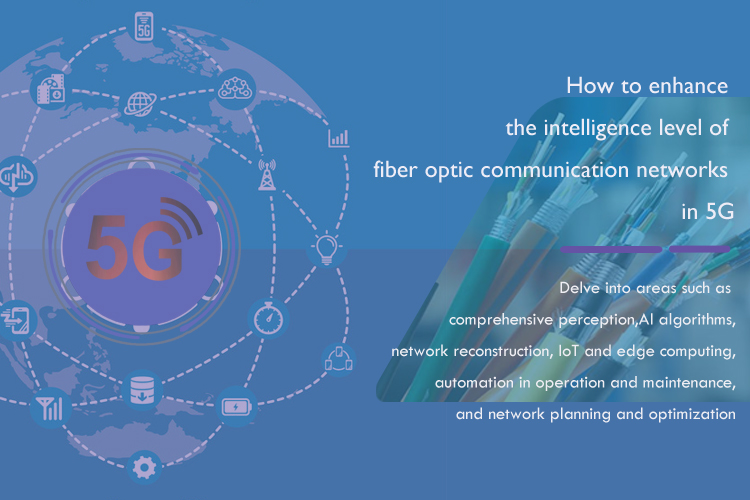How to enhance the intelligence level of fiber optic communication networks in 5G?
Introduction
Fiber optic communication networks play a vital role in our increasingly digital and connected world. With the advent of 5G, the demands on these networks have skyrocketed, requiring advanced strategies to enhance their intelligence level. In this article, we will explore various approaches to boosting the intelligence of fiber optic communication networks in the context of 5G. We will delve into areas such as comprehensive perception, AI algorithms, network reconstruction, IoT and edge computing, automation in operation and maintenance, and network planning and optimization.

1.Realize comprehensive perception by deploying perception devices to monitor the real-time status of the network: To enhance the intelligence level of fiber optic communication networks in 5G, it is crucial to have a comprehensive view of the network's real-time status. This can be achieved by deploying perception devices that monitor various parameters such as signal strength, bandwidth utilization, latency, and packet loss. By continuously monitoring these metrics, network administrators can gain valuable insights into network performance and identify potential bottlenecks or issues that need to be addressed promptly.
2.Apply AI algorithms to analyze and accurately predict network data: Once the network's real-time status has been captured, the next step is to apply artificial intelligence (AI) algorithms to analyze and accurately predict network data. These algorithms can identify patterns, anomalies, and potential failures in the network. By leveraging AI, network administrators can proactively mitigate issues, optimize routing, and predict network behavior more accurately. This not only enhances the overall intelligence of the network but also enhances its reliability and availability.
3.Reconstruct the network using software-based methods such as SDN/NFV: Software-based methods such as Software-Defined Networking (SDN) and Network Function Virtualization (NFV) offer innovative ways to enhance the intelligence of fiber optic communication networks in 5G. SDN decouples the network control plane from the data plane, allowing for more flexible and dynamic network management. NFV, on the other hand, virtualizes network functions, enabling the rapid deployment of new services. By adopting SDN and NFV, networks can become more agile, scalable, and intelligent, adapting to the changing demands of 5G.
4.Promote the Internet of Things (IoT) and edge computing to distribute intelligent capabilities to the edge: The Internet of Things (IoT) and edge computing are revolutionizing the way we interact with technology. In the context of fiber optic communication networks in 5G, IoT devices and edge computing can play a crucial role in enhancing their intelligence. By distributing intelligent capabilities to the edge of the network, latency can be reduced, and real-time decision-making can be achieved. IoT devices can provide valuable data that can be analyzed at the edge, enabling faster response times, improved network efficiency, and enhanced user experiences.
5.Improve the level of automation in operation and maintenance, using machine learning to automate problem-solving: Automation is a key component in enhancing the intelligence of fiber optic communication networks in 5G. By leveraging machine learning algorithms, networks can automate problem-solving, reducing the need for manual intervention and optimizing operation and maintenance processes. Machine learning algorithms can detect patterns, predict failures, and automatically take corrective actions. This not only saves time and effort but also improves network reliability and enables faster response times to potential issues.
6.Strengthen network planning and optimization, continuously improving network design: To enhance the intelligence level of fiber optic communication networks in 5G, network planning and optimization play a critical role. By continuously improving network design, factors such as signal propagation, bandwidth allocation, and routing efficiency can be optimized. Network planners can leverage sophisticated tools and algorithms to simulate various scenarios, predict network behavior, and identify potential bottlenecks. By optimizing network design, the intelligence level of these networks can be significantly enhanced.
Conclusion
Enhancing the intelligence level of fiber optic communication networks in the age of 5G is paramount for the seamless and efficient operation of modern communication systems. By deploying perception devices, applying AI algorithms, reconstructing networks through software-based methods, promoting IoT and edge computing, improving the level of automation in operation and maintenance, and strengthening network planning and optimization, we can achieve a higher intelligence level in these networks. These advancements will not only enable faster and more reliable communication but also drive innovation and further shape our connected world.
FAQs:
Q1: Why is it important to deploy perception devices in fiber optic communication networks?
A1: Deploying perception devices helps monitor the real-time status of the network, allowing network administrators to identify potential issues and optimize network performance proactively.
Q2: How do AI algorithms enhance the intelligence level of fiber optic communication networks in 5G?
A2: AI algorithms analyze network data, identify patterns and anomalies, and predict future network behavior, enabling network administrators to make more informed decisions and optimize network performance.
Q3: What are SDN and NFV, and how do they enhance the intelligence of fiber optic communication networks?
A3: SDN decouples the network control plane from the data plane, providing more flexibility and dynamic management. NFV virtualizes network functions, enabling the rapid deployment of new services. Together, they make networks more agile, scalable, and intelligent.
Q4: How does edge computing enhance the intelligence level of fiber optic communication networks?
A4: Edge computing distributes intelligent capabilities to the edge of the network, reducing latency and enabling real-time decision-making. This improves network efficiency and enhances user experiences.
Q5: How does automation using machine learning algorithms benefit fiber optic communication networks?
A5: Automation using machine learning algorithms automates problem-solving, reduces manual intervention, and improves network reliability and response times to potential issues.
Keywords: fiber optic communication networks, 5G, comprehensive perception, AI algorithms, software-based methods, SDN, NFV, IoT, edge computing, automation, operation and maintenance, network planning, optimization.

 The Future of Fiber Optic Communication Network Architecture: Evolution and the Role of SDON Technology
The Future of Fiber Optic Communication Network Architecture: Evolution and the Role of SDON Technology
 What opportunities and challenges does free-space optical communication technology face?
What opportunities and challenges does free-space optical communication technology face?
 Opelink MPO Products for High-Speed Data Center Applications
Opelink MPO Products for High-Speed Data Center Applications
 CWDM vs. DWDM: Which Optical Transmission Technology Should You Choose?
CWDM vs. DWDM: Which Optical Transmission Technology Should You Choose?